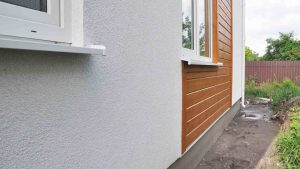When it comes to improving the energy efficiency and aesthetics of your home, insulation plays a vital role. It helps regulate the temperature inside your living spaces, reduces energy consumption, and enhances the overall comfort of your home. If you’re considering insulation options, you’ve likely come across two popular choices: external wall insulation and internal wall insulation. In this blog post, we’ll explore the differences between these two methods and help you make an informed decision for your home.
External Wall Insulation
External wall insulation, also known as EWI, involves adding insulation material to the exterior walls of your property. This insulation layer is then covered with a protective render, creating a new exterior finish. EWI offers numerous benefits, including improved energy efficiency, reduced heat loss, and enhanced weather resistance.
Advantages of External Wall Insulation
Enhanced Energy Efficiency: EWI acts as a continuous thermal barrier, preventing heat from escaping through your walls. This helps to keep your home warm during the winter months and cool in the summer, reducing your reliance on heating and cooling systems.
Increased Weather Resistance: By adding a protective render to the exterior walls, EWI creates a barrier against moisture, wind, and rain. This protects your property from damage caused by dampness and helps to extend the lifespan of your walls.
Aesthetically Pleasing: External wall insulation can completely transform the appearance of your home. With a wide range of render finishes available, you can choose a design that matches your personal style and enhances the overall kerb appeal of your property.
Internal Wall Insulation
Internal wall insulation, often referred to as IWI, involves insulating the inner side of external walls. This method typically requires removing and replacing the existing plasterboard, followed by the installation of insulation material and the application of a new finish.
Advantages of Internal Wall Insulation
-
Cost-Effective: Compared to external wall insulation, internal wall insulation is generally more affordable. The installation process is simpler and requires less material, making it a budget-friendly option for improving your home’s energy efficiency.
-
Minimal Disruption: With internal wall insulation, the majority of the work is carried out inside your home. This means there is minimal disruption to the external appearance of your property, making it a convenient choice for homeowners who wish to avoid major renovations.
-
Flexibility in Design: Internal wall insulation allows you to retain the original exterior appearance of your home. The insulation and finishing materials can be customised to match your existing interior décor, ensuring a seamless integration with your home’s design.
Conclusion
External wall insulation and internal wall insulation are both effective methods for enhancing the energy efficiency of your home and improving its overall comfort. The choice between these two options depends on various factors such as budget, aesthetic preferences, and the condition of your existing walls.
At ShapeUp Ltd, we specialise in external wall insulation and rendering services. Our team of experts can guide you through the decision-making process, helping you choose the most suitable insulation solution for your home. Whether you opt for external or internal wall insulation, the result will be a cosier, more energy-efficient living space that adds value to your property.
Contact us today to learn more about our insulation services and start your journey towards a more sustainable and comfortable home.








